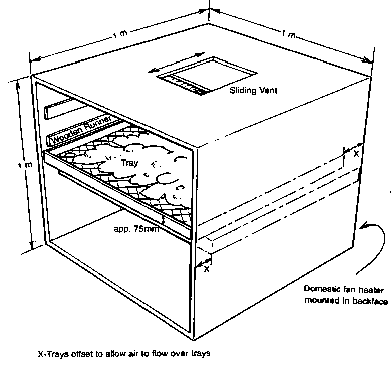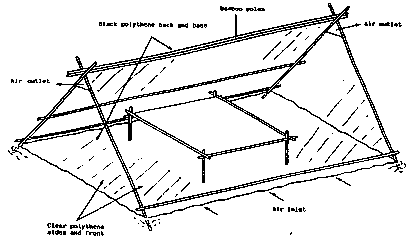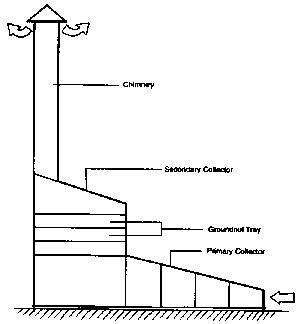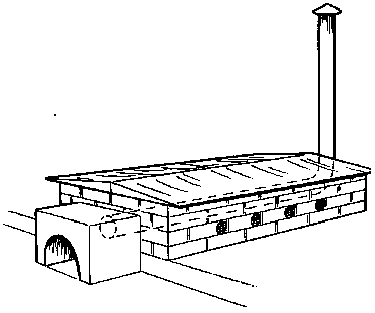Comment conserver les aliments par technologies de séchage à petite échelle
Globalement, le séchage est la méthode la plus largement utilisée pour la conservation des aliments destinés à la maison ou à la vente. La méthode la plus courante consiste à étendre simplement le produit au soleil sur des nattes, des toits ou sur un sol sec. Ceci est connu comme séchage au soleil. Comme indiqué, ci-dessous, le séchage simple au soleil a des avantages et des désavantages.
|
Avantages |
Désavantages |
|
Presque sans frais Idéal pour les produits qui ont peu ou pas du tout de valeur ajoutée Aliments habituellement séchés près du domicile |
Ouvert à la contamination par la poussière Totalement dépendant du beau temps Très faible taux d’assèchement avec le danger de formation de moisissures Ne peuvent pas être séchés suffisamment afin de prévenir l’humidité et la croissance microbienne |
Le séchage au soleil reste, cependant, le seul choix économique pour les populations pauvres lors du séchage des aliments tels que les céréales en grandes quantités et où il y a peu ou pas du tout de valeur ajoutée au séchage.
Lorsque le séchage des aliments, comme les fruits, légumes, épices, herbes et noix, ont une valeur ajoutée au séchage et dans ce cas, un investissement dans des technologies améliorées de séchage, peut être économiquement viable. Cette technique succincte, décrit une amélioration des systèmes utilisables par les petits producteurs.
Sommaire
Séchoirs solaires
Les séchoirs solaires utilisent une construction simple pour un meilleur usage de la chaleur du soleil. Dans de bonnes conditions climatiques, ils peuvent fournir de nombreux avantages par le séchage au soleil. Il s'agit notamment de:
la hausse des températures de séchage qui aboutit à un plus court terme de séchage et la capacité de sécher à une plus faible teneur en humidité finale
la protection contre la contamination par la poussière et des averses de pluie
ils sont peu coûteux et faciles à construire dans des ateliers locaux
Les séchoirs solaires se composent d'un panneau transparent au-dessus d'une cavité ou d’un collecteur qui est peint en noir, ce qui absorbe la chaleur du soleil. Le polyéthylène, qui est très bon marché, est couramment utilisé pour couvrir le panneau, mais après quelques mois, il devient jaune et opaque et doit être remplacé. Des films en plastique qui ne sont pas endommagés par les rayons du soleil sont maintenant de plus en plus disponibles et devraient être utilisés si possible. Bien que plus coûteux, ils ont une durée de 5 ans ou plus. Il est très important de faire pivoter le collecteur à l'angle correct au soleil:
The angle should be greater than 15 to allow rain water to run off
The collector should be angled at 90 to the mid-day sun
The collector should face south in the Northern hemisphere and north in the Southern
The collector should be sited away from shadows from trees or buildings
Tent solar dryers, as shown in Figure 1, are cheap and simple to build and consist of a frame of wood poles covered with plastic sheet. Black plastic should be used on the wall facing away from the sun. The food to be dried is placed on a rack above the ground. Tent dryers provide protection against rain, insects and dust and, in the case of fish for example, can reduce drying times by 25%. Tent dryers can also be taken down and stored when not in use. They have the disadvantage of being easily damaged by strong winds
The Brace solar dryer as shown in Figure 2 has been widely used for small scale food drying. It consists of a wooden box with a hinged transparent lid. The inside is painted black and the food supported on a mesh tray above the dryer floor. Air flows into the chamber through holes in the front and exits from vents at the top of the back wall. Brace type dryers achieve higher temperatures, and thus shorter drying times, than tent dryers.
A further design of solar dryer uses of a separate solar collector which supplies heated air to a chamber containing trays of food. This is known as an indirect solar dryer and a typical design is shown in Fig 3. Dryers of this type have several advantages over direct dryers which include:
• the food is not exposed to the direct rays of the sun which reduces the loss of colour and vitamins
• the collector can be large and thus heat greater quantities of air
Indirect dryers are, however, more expensive and complex to construct.
The obvious problem with solar dryers is their inability to work when there is little or no sunlight. The McDowell dryer shown in Fig 4 attempts to overcome this problem by combining solar heat and heat from wood burning in a fire box. The Mc Dowell dryer consists of a block structure with a fire box at one end. Heat from the fire passes through a metal pipe below the tray of food and exits via a chimney. The whole structure supports a glazed solar roof.
Small Electric Dryers, as shown in Figure 5, can be constructed at a cost equal to or less than the solar dryers described above. Typically, such a dryer consists of a plywood box one metre cube, with a door to the front. Between 6 and 10 mesh trays are supported on wooden runners on the dryer walls. Heated air is supplied by a domestic 2kw fan heater to the rear base wall. The heater should be re-wired with an external thermostat (placed in the drying chamber) so that the heater elements are controlled by the thermostat while the fan runs all the time. This is a simple job that can be carried out by a competent electrician. The air exits via an opening at the top of the rear wall. The trays should be arranged so as to cause the air to follow a zig-zag path as it passes through the dryer as shown in Figure 5.

Figure 5: Small electric dryer. The air should follow a zigzag path.
Provided sufficient value is added by drying to cover electricity costs, such dryers offer distinct advantages over solar dryers which include:
• greater daily output
• higher drying temperatures and thus considerably more rapid drying
• faster drying due to the forced air flow
• total independence from weather conditions
• good control of the drying process
References and further reading
• Drying of foods, Practical Action Technical Brief
• Solar drying, Practical Action Technical Brief
• Drying of Chillies, Practical Action Technical Brief
• Drying of Apricots, Practical Action Technical Briefs
• Drying Food For Profit: A Guide for Small Business, Barrie Axtell, 2002, ITDG Publishing ISBN 1 85339520 X
• Setting up a Food Drying Business: A Step-by-step Guide, Fabrice Thuillier, 2002, ITDG Publishing, ISBN 1 85339 498 X
• Drying Foodstuffs, Jean Françoia Rozis, 1997, Backuys Publishers
This Howtopedia entry was derived from the Practical Action Technical Brief Energy from the Wind.
To look at the original document follow this link: http://
http://www.practicalaction.org/?id=technical_briefs_food_processing
Related Articles
- How to Preserve Food with Small Scale Drying Technologies
- How to Preserve Food by Drying
- How to Use Sun Power
- How to Make Chocolate
- How to Preserve Tomato
- How to Preserve Food with a Solar Dryer
- How to Process Spice
- How to Process Turmeric
- How to Build a Tray Dryer
- The Anagi Tray Dryer
- How to Dry Chillies
- How to Process Pepper
Usefull addresses
Practical Action
The Schumacher Centre for Technology & Development, Bourton on Dunsmore, RUGBY, CV23 9QZ, United Kingdom.
Tel.: +44 (0) 1926 634400, Fax: +44 (0) 1926 634401
e-mail:practicalaction@practicalaction.org.uk
web:www.practicalaction.org




